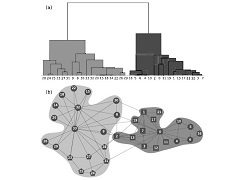Community detection in networks using self-avoiding random walks.
BAGNATO, Guilherme de Guzzi; RONQUI, José Ricardo Furlan; TRAVIESO, Gonzalo.
BAGNATO, Guilherme de Guzzi; RONQUI, José Ricardo Furlan; TRAVIESO, Gonzalo.
 Abstract: Different kinds of random walks have proven to be useful in the study of structural properties of complex networks. Among them, the restricted dynamics of self-avoiding random walks (SAW), which visit only at most once each vertex in the same walk, has been successfully used in network exploration. The detection of communities of strongly connected vertices in networks remains an open problem, despite its importance, due to the high computational complexity of the associated optimization problem and the lack of a unique formal definition of communities. In this work, we propose a SAW-based method to extract the community distribution of a network and show that it achieves high modularity scores, specially for real-world networks. We combine SAW with principal component analysis to define the dissimilarity measure to be used for agglomerative hierarchical clustering. To evaluate the performance of this method we compare it with four popular methods for community detection: Girvan?Newman, Fastgreedy, Walktrap and Infomap using two types of synthetic networks and six well-known real-world cases. Abstract: Different kinds of random walks have proven to be useful in the study of structural properties of complex networks. Among them, the restricted dynamics of self-avoiding random walks (SAW), which visit only at most once each vertex in the same walk, has been successfully used in network exploration. The detection of communities of strongly connected vertices in networks remains an open problem, despite its importance, due to the high computational complexity of the associated optimization problem and the lack of a unique formal definition of communities. In this work, we propose a SAW-based method to extract the community distribution of a network and show that it achieves high modularity scores, specially for real-world networks. We combine SAW with principal component analysis to define the dissimilarity measure to be used for agglomerative hierarchical clustering. To evaluate the performance of this method we compare it with four popular methods for community detection: Girvan?Newman, Fastgreedy, Walktrap and Infomap using two types of synthetic networks and six well-known real-world cases. | |
| Physica A |
| v. 505, p. 1046-1055 - Ano: 2018 |
| Fator de Impacto: 2,243 |
| http://dx.doi.org/10.1016/j.physa.2018.04.006 |  @article={002884760,author = {BAGNATO, Guilherme de Guzzi; RONQUI, José Ricardo Furlan; TRAVIESO, Gonzalo.},title={Community detection in networks using self-avoiding random walks},journal={Physica A},note={v. 505, p. 1046-1055},year={2018}} @article={002884760,author = {BAGNATO, Guilherme de Guzzi; RONQUI, José Ricardo Furlan; TRAVIESO, Gonzalo.},title={Community detection in networks using self-avoiding random walks},journal={Physica A},note={v. 505, p. 1046-1055},year={2018}} |




